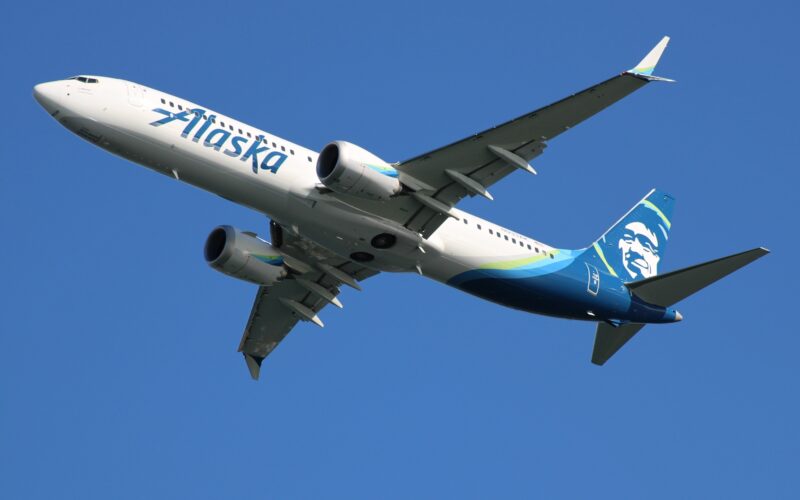More carriers have confirmed that they are grounding their Boeing 737 MAX 9 fleets after an Alaska Airlines 737-9 suffered a plug door blowout shortly after takeoff.
The Alaska Airlines Boeing 737 MAX 9 left Portland International Airport (PDX) on January 5, 2024, just after 5pm local time but shortly after takeoff a plug door separated from the aircraft.
On January 6, 2024, the Federal Aviation Administration (FAA) issued an Emergency Airworthiness Directive (EAD) for inspections to be carried out on 171 Boeing 737 MAX 9 jets worldwide.
“The FAA is requiring immediate inspections of certain Boeing 737 MAX 9 planes before they can return to flight,” FAA Administrator Mike Whitaker said. “Safety will continue to drive our decision-making as we assist the NTSB’s investigation into Alaska Airlines Flight 1282.”
In response to the incident and EAD, United Airlines grounded all its 737-9 aircraft after initially advising only a select number of planes would be inspected.
According to the BBC, Turkish Airlines grounded four of its 737 MAX 9 aircraft following the incident.
The Panama national flag-carrier, Copa Airlines confirmed it had grounded 21 737-9s due to the EAD and the Mexican airline, AeroMexico, said it all its MAX 9s will undergo inspections.
The UK’s Civil Aviation Authority (CAA) confirmed there are no British registered Boeing 737 MAX 9s, but it had written to all foreign carriers that operate the jet to ensure checks are carried out before entering UK airspace.
Alaska Airlines Flight 1282 made an emergency landing in Portland, Oregon on January 5, after an issue with pressurization. A panel of the fuselage, including the panel’s window, popped off shortly after takeoff.
— Massimo (@Rainmaker1973) January 6, 2024
[📹 vy.covers]https://t.co/VRzA10AilE
The Directorate General of Civil Aviation (DGCA) in India also requested that Air India Express, Akasa Air and SpiceJet carry out a “one-time inspection of the emergency exits immediately on all Boeing 737-8 Max aircraft”. No Indian airline operates the 737-9.
Accident investigators from the National Transportation Safety Board (NTSB) arrived in Portland in the United States (US) on January 6, 2024, to begin evidence gathering and asked for the public’s help to locate the plug door that separated from the Alaska Airlines plane in the Cedar Hills area, near PDX.
The NTSB Chair, Jennifer Homendy, also traveled to Portland and in a statement said: “We are very, very fortunate here that this didn’t end up in something more tragic […] No one was seated in 26A and 26B, where that door plug is.”
On January 24, 2024, Alaska Airlines said 18 of its 737-9 MAX aircraft had received in-depth inspections and were put back into service.
However, following the FAA’s EAD those aircraft were then pulled from service until details about possible additional maintenance work are confirmed.
The airline also confirmed that several passengers onboard Flight AS1282 experienced injuries that required medical attention.
In its latest statement Boeing said: “Safety is our top priority and we deeply regret the impact this event has had on our customers and their passengers. We agree with and fully support the FAA’s decision to require immediate inspections of 737-9 airplanes with the same configuration as the affected airplane. In addition, a Boeing technical team is supporting the NTSB’s investigation into last night’s event. We will remain in close contact with our regulator and customers.”
#Ongoing Alaska Airlines Flight 1282, a B-737, made a successful emergency landing after an incident over Oregon (US). All 117 aboard were unharmed. Jet experienced a rapid decompression after losing a fuselage panel, on the left of the cabin. Updates when possible pic.twitter.com/66W89ivHG6
— Air Safety #OTD by Francisco Cunha (@OnDisasters) January 6, 2024
A plug door (positioned between the wing and the rear cabin exit) can be activated as an emergency exit during manufacturing if required by an airline.
As the Alaska Airlines 737-9 MAX seating configuration does not meet the passenger number threshold that requires additional emergency exits the door was ‘plugged’.
To those passengers onboard the Alaska Airlines 737-9, the door would have appeared as simply a window but from the outside of the plane the optional emergency exit is visible.
The Alaska Airlines aircraft, registered as N704AL, involved in the incident was delivered by Boeing to the carrier in October 2023 and entered service on November 11, 2023.

